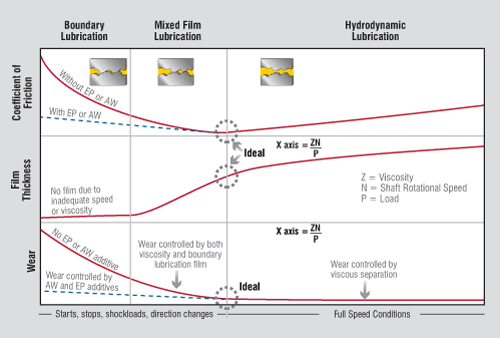A Balanced Approach to Lubrication Effectiveness
Tags: maintenance and reliability, contamination control
This is the second in a series of articles that illustrate the importance of a holistic effort to manage the root causes of failure and, moreover, the interaction between non-lubrication-related root causes and lubrication effectiveness.
For most mechanical equipment, if the machine is aligned, balanced, fastened down tight and well lubricated, it has a pretty good chance of running a long and dependable life. In my last column, I discussed the relationship between alignment and lubrication. Now, I will focus on balance.
In a nutshell, a rotating element is balanced when the distribution of mass is equal around the circumference of the element. It’s unbalanced when the distribution is uneven. Because the fan, pump impeller or other rotating element is turning, a mass imbalance produces relative centrifugal force (RCF). RCF is calculated using the following equation:
RCF = 1.77 x W x D x (RPM/1,000)2
Where: RCF = relative centrifugal force
W = unbalanced force in ounces
D = distance from centerline
RPM = rotations per minute
In essence, if a machine has a five-ounce mass unbalance at some point around the circumference of the rotating elements, and the position of the unbalance is 20 inches from the centerline, the resultant relative centrifugal force is 2,294 pounds of load. Doubling the unbalanced load or the distance from the centerline doubles the RCF.
Changing speed has a geometric effect on the RCF. Just a small amount of unbalanced force can significantly increase the load on the machine and the lubricant film.

Figure 1. The Stribeck Equation and Curve
Utilizing Stribeck’s Equation
Let’s consider Stribeck’s equation:
ZN/P
Where: Z = the oil’s viscosity
N = speed
P = load on the lubricant film
Figure 1 illustrates, according to Stribeck’s equation, that as the viscosity or speed increases, the lubricant film increases, which in turn reduces friction – at least up to the point that boundary lubrication is overcome and any further increases in viscosity and/or speed results in fluid friction and energy losses.
But increasing load reduces the lubricant film. Unbalance effectively increases the load, thus decreasing the lubricant film, which increases the likelihood of boundary contact and wear. While it may appear obvious to those familiar with Stribeck’s famous equation and model that increasing load as a result of unbalance increases the risk of boundary contact and wear, let us probe a little deeper.
What if the unbalance problem isn’t bad enough to produce boundary lubrication? Are you OK? Not really. For mechanical systems, research suggests that particles are the wearing agent in 70 to 80 percent of all failures. But the particles don’t act alone.
Suppose you have a machine that in a balanced state operates with a 10-micron film. A little mass unbalance reduces the lubricant film, per the Stribeck curve, to about 3 microns, but it’s not bad enough to produce boundary contact conditions.
If the oil cleanliness is ISO 17/15/12, there are approximately 70 particles per milliliter that are 10 microns or larger. In a typical distribution of particles, there are approximately six times as many particles greater than 3 microns than there are particles greater than 10 microns. So, the number of potential wearing particle contacts increases from 70 to about 400 particles per milliliter of fluid.
This slight unbalance problem produces a net effect that’s equivalent to increasing your ISO Code from 17/15/12 to 19/17/14 or more than 20/18/15, which can reduce the life of your machine by as much as half!
Moreover, smaller particles, for a given hardness value, are tougher. For a particle to yield in the contact zone, it must fracture. As particles get smaller, there are fewer cleave lines at which the rupture can occur, so the particle’s friability, or crushability, diminishes.
The Damaging Effects of Water
What about water contamination? Water contamination affects the lubricant film in many ways. First, one element of the somewhat difficult-to-define concept of “lubricant film strength” is the fact that as load applied to oil increases, viscosity increases (to a substantial degree, really).
Water doesn’t possess that same quality, which is one of the reasons why water contamination has such a dramatic influence on the rate of wear, especially in rolling-contact, elastohydrodynamic (EHD) lubrication films where the unit loads are so high. Naturally, increasing the contact forces as a result of unbalance will exacerbate the problem.
Water also causes plenty of erosive damage in machines as a result of vaporous cavitation. Cavitation occurs where pressure transitions quickly from a vacuum to high pressure. In the low-pressure regions, a gas or vapor bubble expands, collecting potential energy – much the same as stretching a rubber band. When the pressure quickly transitions to high pressure, the implosion force is released onto the surface of the machine with great velocity, causing erosion.
Think of the release as the snap that occurs when you release one end of the stretched-out rubber band. When the cavitation is caused by water vapor, the effect is particularly damaging because the vapor changes to a liquid in the process. Unbalance in rotating shafts can exacerbate the pressure differentials around the circumference of a rotating element.
It is important when implementing proactive maintenance that we attend to all of the root causes of failure. They’re all bad enough on their own. When they team up, the situation can really get ugly!